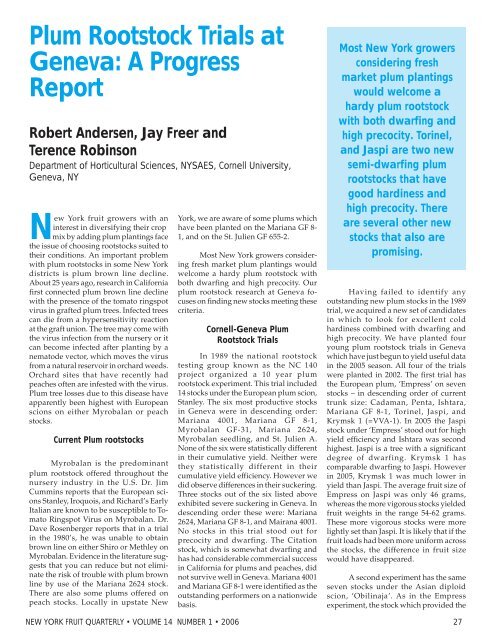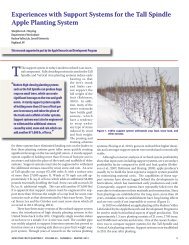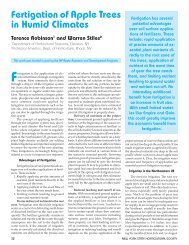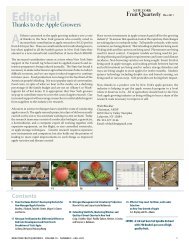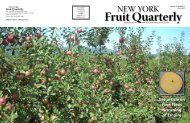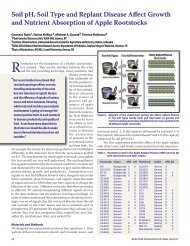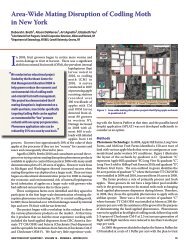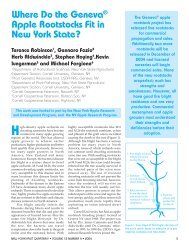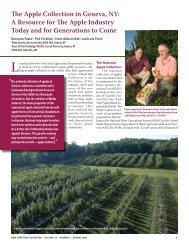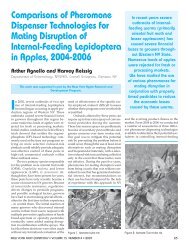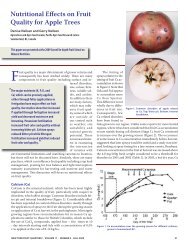plum rootstock trials in Geneva - New York State Horticultural Society
plum rootstock trials in Geneva - New York State Horticultural Society
plum rootstock trials in Geneva - New York State Horticultural Society
You also want an ePaper? Increase the reach of your titles
YUMPU automatically turns print PDFs into web optimized ePapers that Google loves.
Plum Rootstock Trials at<br />
<strong>Geneva</strong>: A Progress<br />
Report<br />
Robert Andersen, Jay Freer and<br />
Terence Rob<strong>in</strong>son<br />
Department of <strong>Horticultural</strong> Sciences, NYSAES, Cornell University,<br />
<strong>Geneva</strong>, NY<br />
<strong>New</strong> <strong>York</strong> fruit growers with an<br />
<strong>in</strong>terest <strong>in</strong> diversify<strong>in</strong>g their crop<br />
mix by add<strong>in</strong>g <strong>plum</strong> plant<strong>in</strong>gs face<br />
the issue of choos<strong>in</strong>g <strong>rootstock</strong>s suited to<br />
their conditions. An important problem<br />
with <strong>plum</strong> <strong>rootstock</strong>s <strong>in</strong> some <strong>New</strong> <strong>York</strong><br />
districts is <strong>plum</strong> brown l<strong>in</strong>e decl<strong>in</strong>e.<br />
About 25 years ago, research <strong>in</strong> California<br />
first connected <strong>plum</strong> brown l<strong>in</strong>e decl<strong>in</strong>e<br />
with the presence of the tomato r<strong>in</strong>gspot<br />
virus <strong>in</strong> grafted <strong>plum</strong> trees. Infected trees<br />
can die from a hypersensitivity reaction<br />
at the graft union. The tree may come with<br />
the virus <strong>in</strong>fection from the nursery or it<br />
can become <strong>in</strong>fected after plant<strong>in</strong>g by a<br />
nematode vector, which moves the virus<br />
from a natural reservoir <strong>in</strong> orchard weeds.<br />
Orchard sites that have recently had<br />
peaches often are <strong>in</strong>fested with the virus.<br />
Plum tree losses due to this disease have<br />
apparently been highest with European<br />
scions on either Myrobalan or peach<br />
stocks.<br />
Current Plum <strong>rootstock</strong>s<br />
Myrobalan is the predom<strong>in</strong>ant<br />
<strong>plum</strong> <strong>rootstock</strong> offered throughout the<br />
nursery <strong>in</strong>dustry <strong>in</strong> the U.S. Dr. Jim<br />
Cumm<strong>in</strong>s reports that the European scions<br />
Stanley, Iroquois, and Richard’s Early<br />
Italian are known to be susceptible to Tomato<br />
R<strong>in</strong>gspot Virus on Myrobalan. Dr.<br />
Dave Rosenberger reports that <strong>in</strong> a trial<br />
<strong>in</strong> the 1980’s, he was unable to obta<strong>in</strong><br />
brown l<strong>in</strong>e on either Shiro or Methley on<br />
Myrobalan. Evidence <strong>in</strong> the literature suggests<br />
that you can reduce but not elim<strong>in</strong>ate<br />
the risk of trouble with <strong>plum</strong> brown<br />
l<strong>in</strong>e by use of the Mariana 2624 stock.<br />
There are also some <strong>plum</strong>s offered on<br />
peach stocks. Locally <strong>in</strong> upstate <strong>New</strong><br />
<strong>York</strong>, we are aware of some <strong>plum</strong>s which<br />
have been planted on the Mariana GF 8-<br />
1, and on the St. Julien GF 655-2.<br />
Most <strong>New</strong> <strong>York</strong> growers consider<strong>in</strong>g<br />
fresh market <strong>plum</strong> plant<strong>in</strong>gs would<br />
welcome a hardy <strong>plum</strong> <strong>rootstock</strong> with<br />
both dwarf<strong>in</strong>g and high precocity. Our<br />
<strong>plum</strong> <strong>rootstock</strong> research at <strong>Geneva</strong> focuses<br />
on f<strong>in</strong>d<strong>in</strong>g new stocks meet<strong>in</strong>g these<br />
criteria.<br />
Cornell-<strong>Geneva</strong> Plum<br />
Rootstock Trials<br />
In 1989 the national <strong>rootstock</strong><br />
test<strong>in</strong>g group known as the NC 140<br />
project organized a 10 year <strong>plum</strong><br />
<strong>rootstock</strong> experiment. This trial <strong>in</strong>cluded<br />
14 stocks under the European <strong>plum</strong> scion,<br />
Stanley. The six most productive stocks<br />
<strong>in</strong> <strong>Geneva</strong> were <strong>in</strong> descend<strong>in</strong>g order:<br />
Mariana 4001, Mariana GF 8-1,<br />
Myrobalan GF-31, Mariana 2624,<br />
Myrobalan seedl<strong>in</strong>g, and St. Julien A.<br />
None of the six were statistically different<br />
<strong>in</strong> their cumulative yield. Neither were<br />
they statistically different <strong>in</strong> their<br />
cumulative yield efficiency. However we<br />
did observe differences <strong>in</strong> their sucker<strong>in</strong>g.<br />
Three stocks out of the six listed above<br />
exhibited severe sucker<strong>in</strong>g <strong>in</strong> <strong>Geneva</strong>. In<br />
descend<strong>in</strong>g order these were: Mariana<br />
2624, Mariana GF 8-1, and Mairana 4001.<br />
No stocks <strong>in</strong> this trial stood out for<br />
precocity and dwarf<strong>in</strong>g. The Citation<br />
stock, which is somewhat dwarf<strong>in</strong>g and<br />
has had considerable commercial success<br />
<strong>in</strong> California for <strong>plum</strong>s and peaches, did<br />
not survive well <strong>in</strong> <strong>Geneva</strong>. Mariana 4001<br />
and Mariana GF 8-1 were identified as the<br />
outstand<strong>in</strong>g performers on a nationwide<br />
basis.<br />
Most <strong>New</strong> <strong>York</strong> growers<br />
consider<strong>in</strong>g fresh<br />
market <strong>plum</strong> plant<strong>in</strong>gs<br />
would welcome a<br />
hardy <strong>plum</strong> <strong>rootstock</strong><br />
with both dwarf<strong>in</strong>g and<br />
high precocity. Tor<strong>in</strong>el,<br />
and Jaspi are two new<br />
semi-dwarf<strong>in</strong>g <strong>plum</strong><br />
<strong>rootstock</strong>s that have<br />
good hard<strong>in</strong>ess and<br />
high precocity. There<br />
are several other new<br />
stocks that also are<br />
promis<strong>in</strong>g.<br />
Hav<strong>in</strong>g failed to identify any<br />
outstand<strong>in</strong>g new <strong>plum</strong> stocks <strong>in</strong> the 1989<br />
trial, we acquired a new set of candidates<br />
<strong>in</strong> which to look for excellent cold<br />
hard<strong>in</strong>ess comb<strong>in</strong>ed with dwarf<strong>in</strong>g and<br />
high precocity. We have planted four<br />
young <strong>plum</strong> <strong>rootstock</strong> <strong>trials</strong> <strong>in</strong> <strong>Geneva</strong><br />
which have just begun to yield useful data<br />
<strong>in</strong> the 2005 season. All four of the <strong>trials</strong><br />
were planted <strong>in</strong> 2002. The first trial has<br />
the European <strong>plum</strong>, ‘Empress’ on seven<br />
stocks – <strong>in</strong> descend<strong>in</strong>g order of current<br />
trunk size: Cadaman, Penta, Ishtara,<br />
Mariana GF 8-1, Tor<strong>in</strong>el, Jaspi, and<br />
Krymsk 1 (=VVA-1). In 2005 the Jaspi<br />
stock under ‘Empress’ stood out for high<br />
yield efficiency and Ishtara was second<br />
highest. Jaspi is a tree with a significant<br />
degree of dwarf<strong>in</strong>g. Krymsk 1 has<br />
comparable dwarf<strong>in</strong>g to Jaspi. However<br />
<strong>in</strong> 2005, Krymsk 1 was much lower <strong>in</strong><br />
yield than Jaspi. The average fruit size of<br />
Empress on Jaspi was only 46 grams,<br />
whereas the more vigorous stocks yielded<br />
fruit weights <strong>in</strong> the range 54-62 grams.<br />
These more vigorous stocks were more<br />
lightly set than Jaspi. It is likely that if the<br />
fruit loads had been more uniform across<br />
the stocks, the difference <strong>in</strong> fruit size<br />
would have disappeared.<br />
A second experiment has the same<br />
seven stocks under the Asian diploid<br />
scion, ‘Obil<strong>in</strong>aja’. As <strong>in</strong> the Empress<br />
experiment, the stock which provided the<br />
NEW YORK FRUIT QUARTERLY • VOLUME 14 NUMBER 1 • 2006 27
earliest ripen<strong>in</strong>g fruit was Krymsk 1 (=VVA-1). A third<br />
experiment has a Japanese diploid scion, NY 61J, on eight<br />
<strong>rootstock</strong>s. This <strong>rootstock</strong> group <strong>in</strong>cludes the same seven<br />
stocks as for Empress plus American <strong>plum</strong>. In these two <strong>trials</strong><br />
with diploid scions, the three smaller stocks <strong>in</strong> both cases were<br />
Jaspi, Krymsk 1, and Tor<strong>in</strong>el. Under the Obil<strong>in</strong>aja scion,<br />
Krymsk 1 produced no suckers <strong>in</strong> 2005, whereas under the<br />
NY 61J scion, Krymsk 1 suckered quite heavily. This probably<br />
reflects much greater w<strong>in</strong>ter cold <strong>in</strong>jury to the trunks of the<br />
NY 61J scion. The NY 61J scion on Tor<strong>in</strong>el had less w<strong>in</strong>ter<br />
<strong>in</strong>jury than on Krymsk 1 and also fewer suckers. Trees on<br />
Tor<strong>in</strong>el were 60-75% smaller than on vigorous stocks, which<br />
is similar to the dwarf<strong>in</strong>g level shown by Krymsk 1.<br />
Our fourth <strong>plum</strong> <strong>rootstock</strong> experiment planted <strong>in</strong> 2002,<br />
contrasts the semi-dwarf<strong>in</strong>g St. Julien stock, GF 655-2 to the<br />
full vigor Mariana GF 8-1, under three European <strong>plum</strong> scions.<br />
Contrary to our expectations, the GF 8-1 stock outperformed<br />
the GF 655-2 <strong>in</strong> both yield and yield efficiency.<br />
Figure 1. Obil<strong>in</strong>aja <strong>plum</strong> trees on three new <strong>rootstock</strong>s. Krymsk 1 on right,<br />
Cadaman <strong>in</strong> center and Ishtara on left.<br />
Additional Rootstock Candidates<br />
for Future Consideration<br />
California researchers plan to<br />
<strong>in</strong>troduce a new Mariana stock, (M 40) <strong>in</strong><br />
the near future. This stock is reported to<br />
be very similar to M 2624 but with many<br />
fewer suckers. This stock and other<br />
Mariana types have similar susceptibility<br />
to brown l<strong>in</strong>e decl<strong>in</strong>e of Mariana 2624.<br />
Ted DeJong and others <strong>in</strong> California<br />
recently named two new dwarf<strong>in</strong>g stocks,<br />
Controller 5 and Controller 9, which may<br />
have promise under <strong>plum</strong>s s<strong>in</strong>ce they are<br />
both peach by <strong>plum</strong> hybrids. We have<br />
Controller 5 <strong>in</strong> our peach <strong>rootstock</strong> trial <strong>in</strong><br />
<strong>Geneva</strong>. It is dwarf<strong>in</strong>g to about 50% of<br />
Lovell size and it has shown much better<br />
cold hard<strong>in</strong>ess than Lovell (see peach<br />
<strong>rootstock</strong> article <strong>in</strong> the last issue). We do<br />
not know the cold hard<strong>in</strong>ess of Controller<br />
9. Hiawatha is another new stock to try<br />
under <strong>plum</strong>s <strong>in</strong> the east. It was bred <strong>in</strong><br />
South Dakota as a scion variety which<br />
tolerates the prairie states’ w<strong>in</strong>ters. It has<br />
shown considerable promise <strong>in</strong> California<br />
as a <strong>rootstock</strong> that is <strong>in</strong>termediate <strong>in</strong> its<br />
dwarf<strong>in</strong>g between Controller 5 and<br />
Controller 9.<br />
References<br />
DeJong, T.M. et al., 2005. Research yields<br />
size-controll<strong>in</strong>g <strong>rootstock</strong>s for<br />
peach production. California Agriculture<br />
59: 80-83.<br />
Mircetich, S.M., and J.W. Hoy. 1981.<br />
Brownl<strong>in</strong>e of prune trees, a disease<br />
associated with tomato r<strong>in</strong>gspot virus<br />
<strong>in</strong>fection of Myrobalan and<br />
peach <strong>rootstock</strong>s. Phytopathology 71<br />
(1) 30-35.<br />
Ogawa, J.M. et al., eds. 1995. Compendium<br />
of Stone Fruit Diseases, APS Press,<br />
M<strong>in</strong>nesota.<br />
Okie, W.R. 1987. Plum Rootstocks –<br />
Chapter 10 <strong>in</strong>: Rootstocks for Fruit<br />
Crops, ed. by Roy C. Rom and Robert<br />
F. Carlson. John Wiley & Sons.<br />
<strong>New</strong> <strong>York</strong>.<br />
Ramsdell, D.C. et al.. 1998. A Study of<br />
Tomato R<strong>in</strong>gspot Virus and Prune<br />
Brown L<strong>in</strong>e Resistance <strong>in</strong> Twentyfive<br />
Rootstock-Scion Comb<strong>in</strong>ations.<br />
Hort Technology 8 (3) 349-353.<br />
Wertheim, S.J. 1998. Rootstock Guide –<br />
Apple, Pear, Cherry, European<br />
Plum. Fruit Research Station,<br />
Wilhelm<strong>in</strong>adorp, The Netherlands.<br />
144 pp.<br />
Westwood, M.N. 1993. Temperate Zone<br />
Pomology. Timber Press. Portland,<br />
Oregon.<br />
Robert Andersen is a recently retired<br />
emeritus professor of Horticulture at<br />
Cornell’s <strong>Geneva</strong> Experiment Station who<br />
specializes <strong>in</strong> the breed<strong>in</strong>g and culture of<br />
stone fruits. He led Cornell’s breed<strong>in</strong>g,<br />
culture and extension program on stone<br />
fruits from 1990 to 2005. Jay Freer is a<br />
research technician that works with Terence<br />
Rob<strong>in</strong>son and Bob Andersen. Terence<br />
Rob<strong>in</strong>son is a research and extension<br />
professor at Cornell’s <strong>Geneva</strong> Experiment<br />
Station who leads Cornell’s research and<br />
extension program <strong>in</strong> high density orchard<br />
systems.<br />
28 NEW YORK STATE HORTICULTURAL SOCIETY


